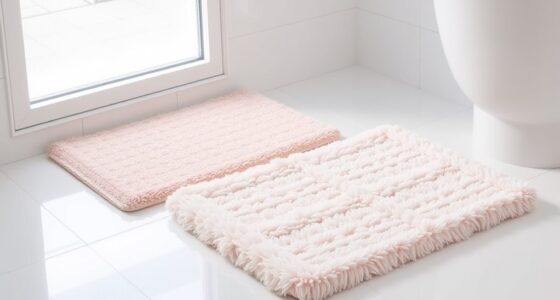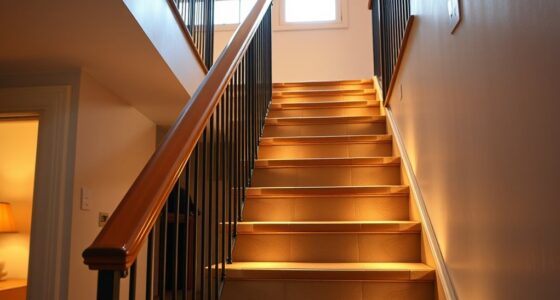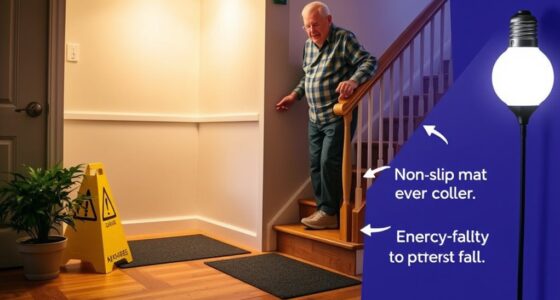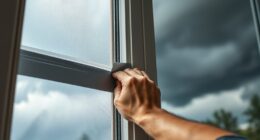Good contrast cues are essential to help you see obstacles clearly and stay safe. Brightly contrasting colors on stairs, handrails, and furniture make hazards stand out against backgrounds. Proper lighting enhances these differences, reducing shadows and dark spots that can hide tripping dangers. Using high contrast in your environment boosts your confidence and helps prevent falls. Keep exploring to learn more simple ways to improve your safety and stay upright.
Key Takeaways
- High contrast between objects and backgrounds helps the brain quickly identify obstacles, reducing fall risk.
- Proper lighting enhances contrast cues, making hazards like stairs and edges more visible.
- Bright, contrasting colors for handrails and steps improve hazard recognition for all users.
- Low contrast environments can cause blurred vision and misjudged distances, increasing fall chances.
- Designing spaces with clear contrast cues promotes safe navigation and independence, especially for older adults.

Have you ever wondered how the contrast between objects and their backgrounds impacts your ability to see clearly and avoid falls? It’s a vital aspect of vision because our brains rely heavily on visual cues to interpret the environment. When objects stand out sharply against their surroundings, your eyes can quickly identify obstacles, pathways, and hazards. Conversely, if there’s little contrast, your vision becomes blurred, making it harder to distinguish where one object ends and another begins. This difficulty can lead to missteps or trips, especially as you age or if you have vision impairments.
Contrast cues are fundamentally the visual signals that help your brain differentiate objects from their backgrounds. Think about how a bright yellow mug stands out on a dark countertop or how a dark doormat is easily spotted on a light-colored floor. These contrasts act like visual markers, guiding your movements and helping you navigate safely. When contrast is high, your eyes can quickly and accurately pick up on important details, reducing the risk of falls. Low contrast, on the other hand, can cause you to overlook obstacles or misjudge distances, increasing your chances of losing your footing.
High contrast helps your brain spot objects quickly, reducing fall risk and improving safe navigation.
Lighting plays a significant role in creating effective contrast cues. Proper illumination enhances the difference between objects and their backgrounds, making hazards more visible. For example, installing bright, even lighting in hallways or staircases can dramatically improve your ability to see steps clearly. Conversely, poor lighting reduces contrast, creating shadows and dark spots that hide potential dangers. That’s why nightlights are so helpful—they boost contrast and keep the environment safe.
Color contrast also matters. Bright, bold colors tend to stand out more than muted tones. Using contrasting colors for handrails, steps, or furniture can help you recognize and avoid hazards more easily. For example, a dark handrail against a light wall provides a visual cue that’s easy to see, even from a distance. This is especially important for individuals with limited vision or those who have difficulty focusing.
The importance of contrast cues becomes even more evident when you’re in unfamiliar settings. When environments are well-designed with high contrast elements, you’re more confident in your movements. This can prevent falls and boost independence. Creating safe, contrasting environments isn’t just about aesthetics; it’s a practical step to protect yourself. It’s about making sure your surroundings communicate clearly, so you can move confidently and avoid unnecessary accidents. Additionally, understanding how bike components work can help prevent mechanical failures that might lead to accidents during rides. Recognizing how contrast influences your vision helps you make smarter choices to stay safe and upright.
Frequently Asked Questions
How Do Contrast Cues Affect People With Visual Impairments?
Contrast cues help people with visual impairments by making objects and surfaces stand out against their backgrounds. You notice differences in color and brightness more easily, which guides your steps and helps you avoid obstacles. When contrast is clear, it boosts your confidence and reduces fall risks. You can navigate more safely and independently, especially in unfamiliar environments, because these cues highlight important features like stairs, edges, and pathways.
Are Contrast Cues Effective for Preventing Falls in All Age Groups?
Contrast cues can be effective across all age groups, but their impact varies. Younger people often adapt quickly, noticing changes and adjusting their movements. Older adults, especially those with visual impairments, benefit markedly because contrast helps distinguish obstacles and surfaces, reducing fall risk. However, the effectiveness depends on individual health and environment. Incorporating contrast cues into your surroundings can enhance safety for everyone, regardless of age.
Can Contrast Enhancements Improve Indoor Safety for Seniors?
Yes, contrast enhancements can improve indoor safety for seniors. When you add high-contrast colors to stairs, handrails, and flooring, you make these features more visible, helping you navigate more confidently. These cues draw your attention to potential hazards, reducing the risk of trips and falls. By creating a safer environment, contrast improvements support your independence and help you move around indoors with greater ease and security.
What Types of Contrast Cues Are Most Beneficial Outdoors?
You benefit most from high-contrast cues outdoors, like brightly colored edges on steps, textured handrails, and contrasting walkway borders. These cues help your eyes distinguish changes in terrain and obstacles clearly, reducing falls. Using vivid paint or tape on stairs and curbs makes them stand out against the environment. Remember, the more noticeable the contrast, the easier it is for your eyes to detect hazards quickly, keeping you safer outside.
Do Contrast Cues Help in Low-Light or Nighttime Conditions?
Yes, contrast cues can help in low-light or nighttime conditions. They enhance your ability to distinguish objects from their surroundings, making it easier to see steps, edges, and obstacles. Using brightly colored or reflective contrast cues, like tape or markings, improves visibility. You should also guarantee good lighting and avoid cluttered pathways. These strategies help you stay aware of your environment and reduce the risk of falls when visibility is limited.
Conclusion
By understanding contrast cues, you gain the power to stay upright and avoid falls. Just as a dark step against a bright floor guides your foot, these visual signals serve as your silent protectors. Without them, you’re left steering a world of uncertainty, vulnerable to missteps. Embrace the importance of contrast—your subtle yet crucial ally—in maintaining balance. Because in the dance between stability and fall, it’s often the smallest cues that make the biggest difference.









